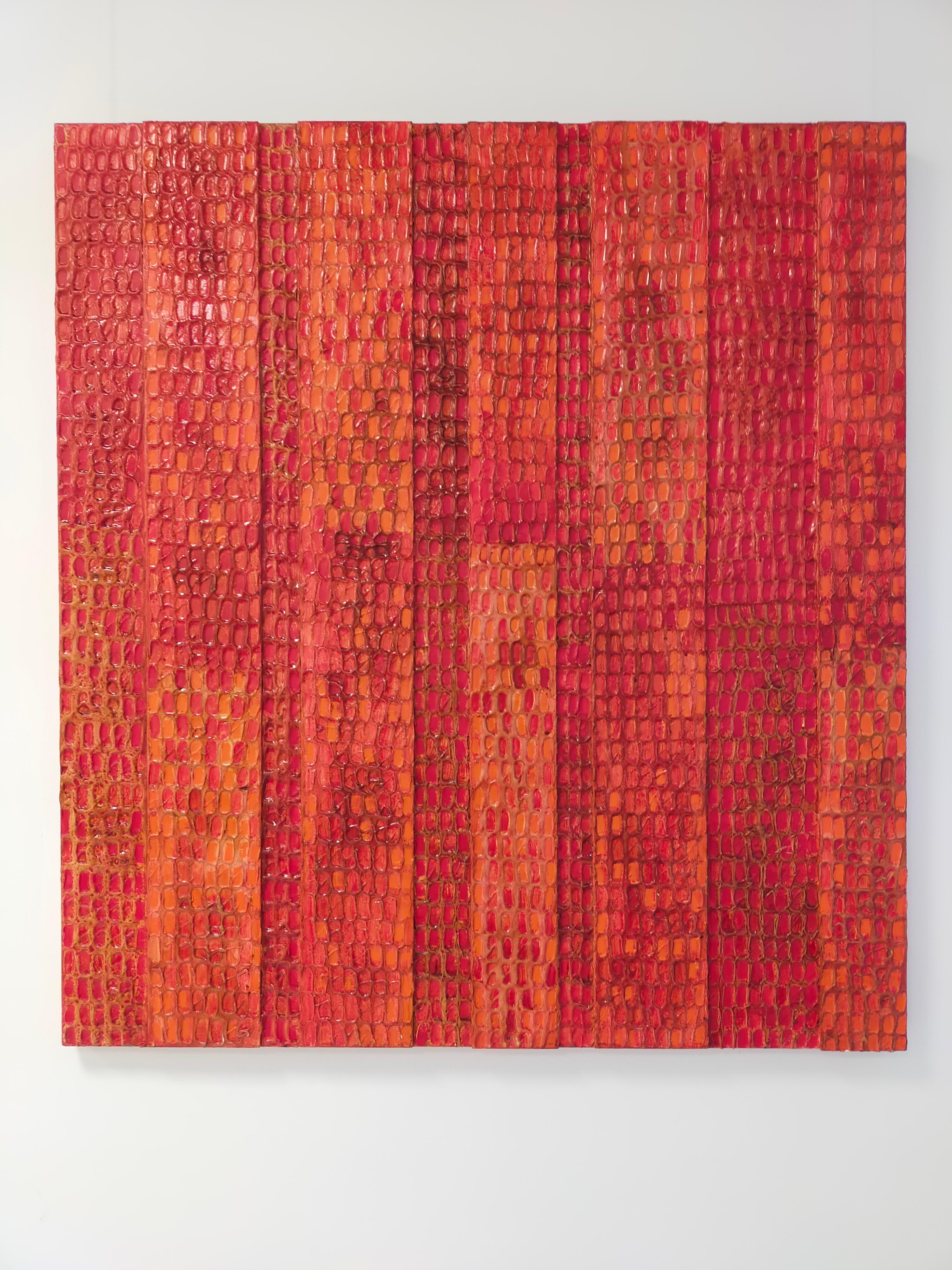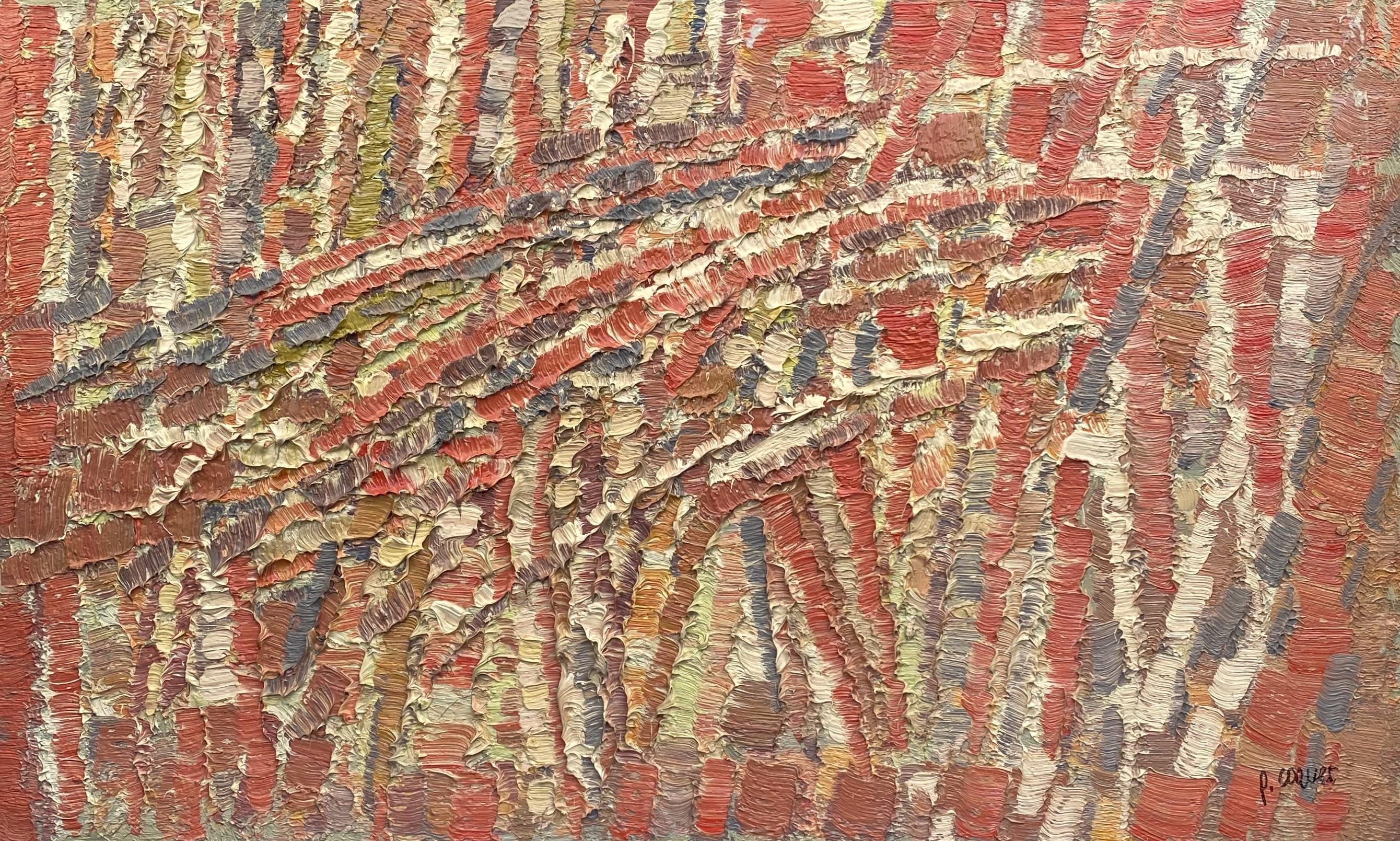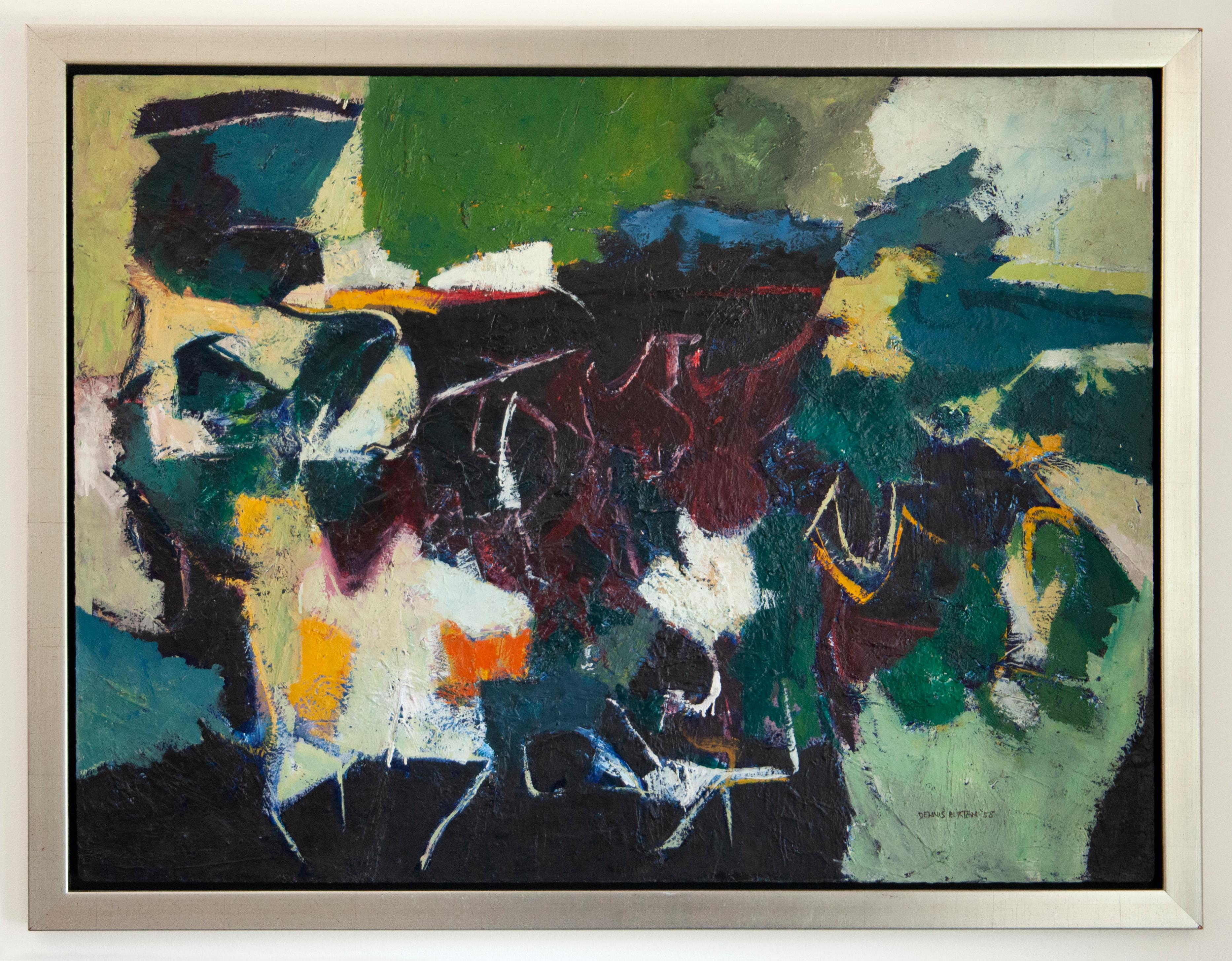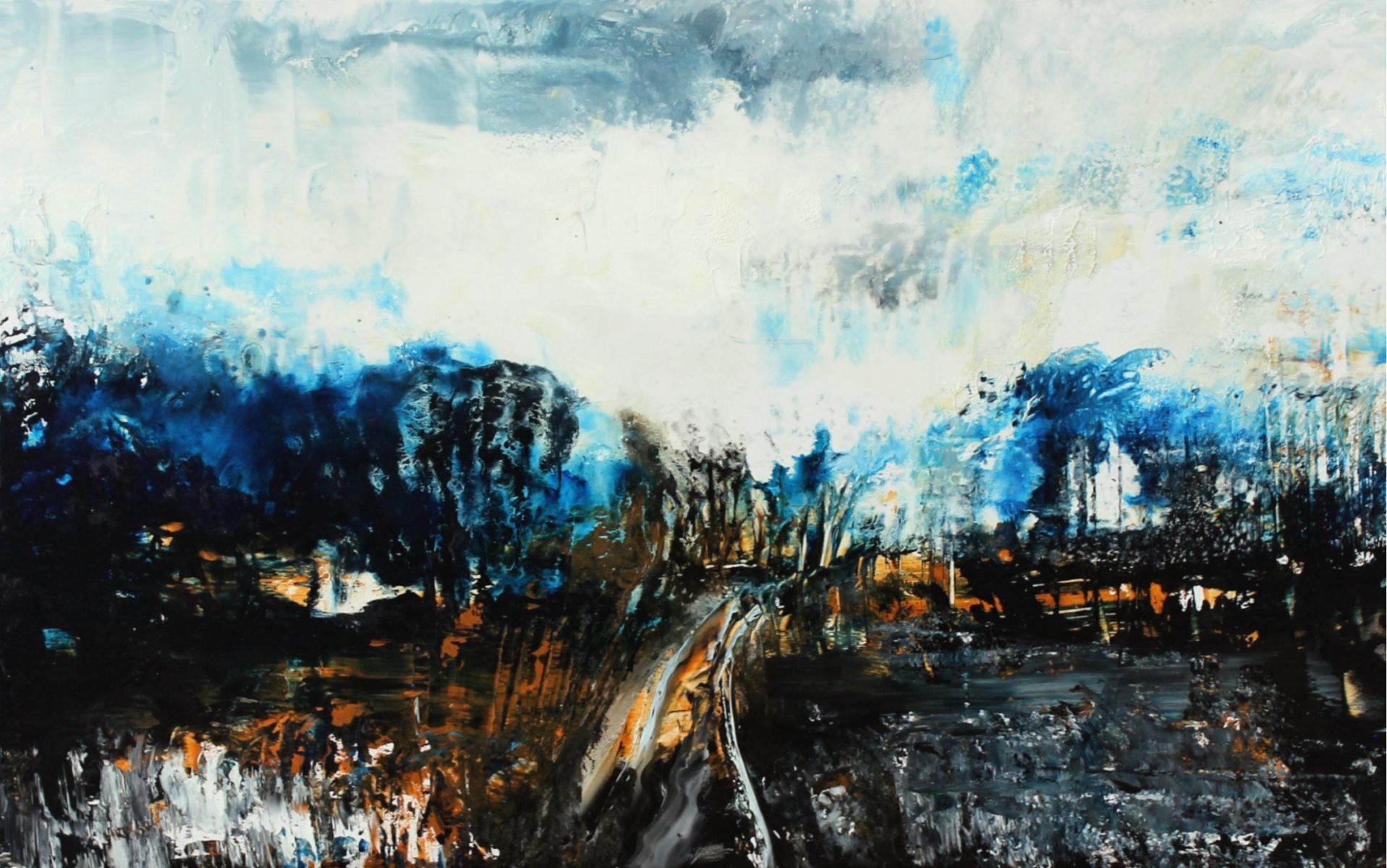Items Similar to "The Serpent" Modern Abstract Painting
Video Loading
Want more images or videos?
Request additional images or videos from the seller
1 of 11
Stanley Bate"The Serpent" Modern Abstract Paintingc. 1960
c. 1960
About the Item
This Modern Abstract Expressionist painting by Stanley Bate is made with oil paint on board and features an earth-toned palette. The artist layers paint on the canvas, creating texture among softly blended muted green and umber colors in a highly abstract composition. The painting itself is 43.5" x 24" and measures 44" x 24.5" x 2" framed. It is signed by the artist in the lower right-hand corner of the painting and is framed in a very thin, off-white floater frame. It is ready to hang.
Stanley Bate was born on March 26, 1903 in Nashville, Tennessee. The Bates were an established Tennessee family, in fact, Henry’s brother William Bate was the governor of Tennessee from 1883-1887 and a United States Senator from 1887-1905. Stanley studied art at the Watkins Institute in Nashville.
In the 1920’s Bate moved to New York City to study at the Art Students League under Frederick Bridgman. He soon landed a job with Encyclopedia Britannica, and from 1927-1929 served as art editor. From 1929 until his death in 1972, Stanley was a self-employed artist. He taught art classes at both the Art Students League and the Albany Institute of History and Art and brought in extra income by making illustrations for magazines such as “Outdoor Life” and “Popular Science”.
On January 27, 1934 Stanley married Emilie Rossel. Emilie had emigrated from Switzerland to New York in 1923. She found work as a governess to Alfred Vanderbilt and later as an executive secretary for Wall Street investment brokers Kahn, Loeb and Co. Emilie met Stanley in New York in the early 1930’s when she attended one of his art exhibitions with a friend. The couple, who had no children, lived on 34th Street in Manhattan. During this period, Bate was producing and exhibiting his art and joined several artists groups. Stanley and Emilie became part of the New York art scene, dining weekly at the Society of Illustrators Clubhouse.
Stanley Bate’s time in New York was pivotal in the formation of his painting style. He lived in New York during the inception of one of the most important Modern Art movements, one that helped New York replace Paris as the center of avant-garde art. This movement, which was called the New York School of artists, was later known as Abstract Expressionism. It was comprised of a loosely associated group of vanguard artists working in New York City during the 1940s and 1950s. The New York School was not defined by a specific style, but instead reflected a fusion of European Modernism and American social relevancy that was depicted in many individual styles. Influences of Surrealism, Cubism, and Modernism can be found in their work, along with an interest in experimenting with non-traditional materials and methods. American art was in the forefront of international avant-garde for the first time.
Stanley Bate was undoubtedly exposed to the varied styles and techniques that were emerging during the formative years of the New York School. Mark Rothko and Robert Motherwell were formulating their versions of color field paintings. Joseph Cornell was experimenting with assemblages, collage and the use of different types of textured paints. Jackson Pollock was adhering objects such as buttons and coins into his early works, while Louise Nevelson was using found objects. Helen Frankenthaler added sand to her early paintings. The New York School artists were undermining traditional fine art by using mixed media and non-traditional methods.
Stanley Bate absorbed these varied influences and soon his early realistic landscapes and still-lifes were replaced with something entirely new. The influence of Cubism, notably the flat shallow space of the picture plane, is obvious in many of Bate’s paintings. Surrealism is evident in Bate’s use of subjects from myth, primitive art and antiquity, along with the Automatism-like line work in his more linear images. The unfettered experimentation of the New York School is everywhere in Stanley Bate’s work. We see nods to color field, collage, the mixing of textures into paint, mixed media, the inclusion of found objects and thick, luscious impasto.
Bate was prolific and experimented in various media including oil, watercolor, lithography, silk screen, wood cut, drawing, collage, ceramics and sculpture. Bate is considered a true Modernist. His work is largely abstract, but sometimes figures and buildings are discernable. He frequently mixed paint, sand and glue together to achieve a textured surface, and then scraped and scratched through this layer to expose some of the underpainting below. His sculpture, which is often whimsical, also reflects the non-traditional methods of the New York School. Bate pioneered the use of enamel and copper in his work. The sculptures are not carved or modeled as was done in the past, but instead are built using mixed media and new materials.
In addition to the New York School influence, many of Bate’s works exhibit a strong connection to the Spanish school, especially the work of Antonio Tapies and Modesto Cuixart. These artists were both part of an avant-garde group known as Art Informel, the Spanish equivalent of Abstract Expressionism. These artists likewise worked in mixed media and introduced objects and texture into their work. Many of Bate’s subjects and titles relate to Spanish locations and words. It is likely that Stanley spent time in Spain and found inspiration there.
By the early 1940s, Stanley and Emilie had started spending weekends in a barn they purchased in Craryville, New York, a few hours north of Manhattan. The barn had no electricity or plumbing, but when the Bates eventually decided to leave New York and live full time in Craryville, they remodeled the barn, putting a gallery downstairs and a studio and living quarters upstairs. Although the Bates moved out of New York City, Stanley remained part of the New York art scene, exhibiting in New York and elsewhere throughout the 50s and 60s. During his lifetime he was represented by the New York galleries Knoedler and Company, Kennedy Galleries, Rose Fried Gallery and Key Gallery, along with Tyringham Gallery located in Tyringham, Massachusetts. Craryville was Stanley’s home until his death on August 21, 1972. Emilie died 1984. Her obituary requested that any donations to be made to the Albany Institute of History and Art. The Institute held a retrospective exhibition of Bate’s work in 1973. Since his death, Stanley Bate’s artwork has been exhibited widely and placed in numerous collections.
About Sorelle Gallery:
Sorelle Gallery is a woman-owned fine art gallery and art advisory firm located in Westport, Connecticut. Representing nearly fifty artists, Sorelle carries a wide variety of art styles from modern abstract to impressionistic landscapes, and more. Sorelle's mission is to not only support the emerging and established artists they represent, but to help clients curate their own spaces, invest confidently, and buy what they love.
- Creator:Stanley Bate (1903 - 1972, American)
- Creation Year:c. 1960
- Dimensions:Height: 44 in (111.76 cm)Width: 24.5 in (62.23 cm)Depth: 2 in (5.08 cm)
- Medium:
- Movement & Style:
- Period:
- Condition:
- Gallery Location:Westport, CT
- Reference Number:
About the Seller
5.0
Vetted Seller
These experienced sellers undergo a comprehensive evaluation by our team of in-house experts.
Established in 2009
1stDibs seller since 2014
379 sales on 1stDibs
Typical response time: <1 hour
- ShippingRetrieving quote...Ships From: Westport, CT
- Return PolicyThis item cannot be returned.
More From This SellerView All
- "Spirits Through Time VI, " Abstract Portrait PaintingBy Ned MartinLocated in Westport, CTThis abstract portrait by Ned Martin blends realistic and abstracted styles. Part of his Spirits Through Time series of female portraits, the woman's face is rendered realistically, ...Category
2010s Abstract Abstract Paintings
MaterialsOil, Board
- "Spirits Through Time IV, " Abstract Figurative PaintingBy Ned MartinLocated in Westport, CTThis painting by Ned Martin blends the artist's signature abstract style with portraiture that is reminiscent of the Old Masters. The softly-executed realistic face and neck of the woman in this painting is contrasted by textured, abstract shapes that compose the rest of the piece, namely, the figure's large, deep red headpiece...Category
2010s Abstract Abstract Paintings
MaterialsOil, Board
- "Spirits Through Time II, " Abstract Figurative PaintingBy Ned MartinLocated in Westport, CTThis painting by Ned Martin blends the artist's signature abstract style with portraiture that is reminiscent of the Old Masters. The softly-executed face and neck of the woman in this painting is contrasted by textured abstract shapes that compose the rest of the painting, namely, the figure's orange, red, and green clothing...Category
2010s Abstract Abstract Paintings
MaterialsBoard, Oil
- "Aragon" Modern Abstract PaintingBy Stanley BateLocated in Westport, CTThis Modern Abstract Expressionist painting by Stanley Bate is made with oil paint on board and features a warm, yellow and umber palette. The artist layers paint on the canvas, creating texture among softly blended colors in a highly abstract composition. The painting itself is 48" x 33"and measures 48.5" x 33.25" x 2" framed. It is signed by the artist in the lower right-hand corner of the painting and is framed in a very thin, off-white floater frame. It is ready to hang. Stanley Bate was born on March 26, 1903 in Nashville, Tennessee. The Bates were an established Tennessee family, in fact, Henry’s brother William Bate was the governor of Tennessee from 1883-1887 and a United States Senator from 1887-1905. Stanley studied art at the Watkins Institute in Nashville. In the 1920’s Bate moved to New York City to study at the Art Students League under Frederick Bridgman. He soon landed a job with Encyclopedia Britannica, and from 1927-1929 served as art editor. From 1929 until his death in 1972, Stanley was a self-employed artist. He taught art classes at both the Art Students League and the Albany Institute of History and Art and brought in extra income by making illustrations for magazines such as “Outdoor Life” and “Popular Science”. On January 27, 1934 Stanley married Emilie Rossel. Emilie had emigrated from Switzerland to New York in 1923. She found work as a governess to Alfred Vanderbilt and later as an executive secretary for Wall Street investment brokers Kahn, Loeb and Co. Emilie met Stanley in New York in the early 1930’s when she attended one of his art exhibitions with a friend. The couple, who had no children, lived on 34th Street in Manhattan. During this period, Bate was producing and exhibiting his art and joined several artists groups. Stanley and Emilie became part of the New York art scene, dining weekly at the Society of Illustrators Clubhouse. Stanley Bate’s time in New York was pivotal in the formation of his painting style. He lived in New York during the inception of one of the most important Modern Art movements, one that helped New York replace Paris as the center of avant-garde art. This movement, which was called the New York School...Category
1960s Abstract Abstract Paintings
MaterialsOil, Board
- "Walk Softly, " Abstract Eagle PaintingBy Ned MartinLocated in Westport, CTThis abstract painting by artist Ned Martin features an eagle in flight, with the background and subject abstracted into small, geometric shapes and sections, with an almost pixelate...Category
2010s Abstract Abstract Paintings
MaterialsMetal
- "Instant Gratification" Abstract Geometric Oil PaintingBy Ned MartinLocated in Westport, CTThis abstract geometric painting by Ned Martin is made with oil on aluminum and board, and features a cool blue-grey palette. It is signed by the artist on the back of the board and ...Category
2010s Abstract Abstract Paintings
MaterialsMetal
You May Also Like
- Antonio Buonfiglio - CENERE ALLA CENERE - Black/whiteLocated in Stienta, ITMixed media oil and ash on canvas. In Antonio Buonfiglio's works, the pictorial surface takes on a thick, vibrant consistency, almost stretching ou...Category
21st Century and Contemporary Abstract Abstract Paintings
MaterialsOil, Board
- Antonio Buonfiglio - DOUBLE TROUBLE - Neutral colorLocated in Stienta, ITMixed media and oil on board. In Antonio Buonfiglio's works, the pictorial surface takes on a thick, vibrant consistency, almost stretching out to ...Category
21st Century and Contemporary Abstract Abstract Paintings
MaterialsOil, Board
- Antonio Buonfiglio - OUT OF RED - Red - Oil PaintingLocated in Stienta, ITTechnique Mixed oil on wood. The artist, In order to give more character and personalization to this work of great effect and color, decorates the painting with his own fingerprints. In Antonio...Category
21st Century and Contemporary Abstract Abstract Paintings
MaterialsOil, Board
- Composition abstraite/Abstract compositionLocated in Montfort l’Amaury, FRReference number A214 The painting is not framed but it could be with a natural oak floated or black frame (see how it would look like on the simulation photo. Price for the frame : ...Category
1970s Abstract Abstract Paintings
MaterialsOil, Board
- EdgeLocated in Austin, TXOil on board. Signed and dated lower right and verso, titled verso. 36.25 x 48 in. 40.5 x 52.25 in. (framed) Framed in contemporary silver, tiered floater frame. Dennis Eugene Norman Burton was a Canadian modernist who was born in Lethbridge, Ontario. He attended the Ontario College of Art from 1952 to 1956, and worked for the Canadian Broadcasting Corporation (CBC) as a graphic designer until 1960. Inspired by a 1955 exhibition of the “Painters Eleven” at Toronto’s Hart House, as well as American Abstract Expressionist artists such as Robert Motherwell, Jack Tworkov, and Willem de Kooning, Burton shifted his focus toward abstraction in the mid-1950s. Burton showed with the famed Isaacs Gallery in Toronto, becoming one of the youngest members on the gallery’s roster. A talented musician, he also played saxophone in the Artist’s Jazz Band in Toronto - a pioneering Canadian free-jazz group...Category
1950s Abstract Expressionist Abstract Paintings
MaterialsMasonite, Oil, Board
- Landscape - XXI century, Contemporary Oil & Acrylic Painting, AbstractionBy Monika RossaLocated in Warsaw, PLMONIKA ROSSA studied painting at the University of Arizona, in the Ecole des Beaux Arts in Paris and at the Escuela de Diseno in Barcelona. She practices drawing and easel painting....Category
21st Century and Contemporary Abstract Abstract Paintings
MaterialsOil, Acrylic, Board





